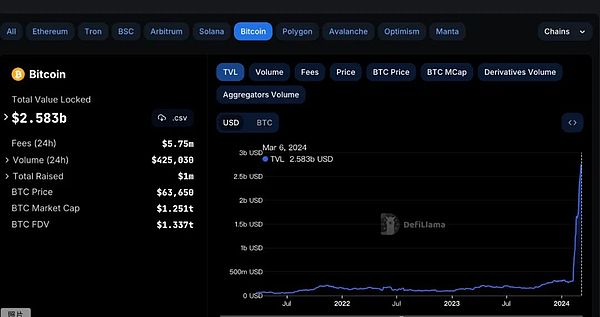
Bitcoin Layer 2 network contains huge potential, but it comes with security risks that cannot be ignored.It is worth noting that these risks vary by participant.For the BTC Layer 2 project party, which costs hundreds of millions of US dollars, the risk challenge is how to safely store and manage these BTC native assets deposited by users to prevent hackers. For ordinary investors participating in the pledge, the risk challenge is how to safely store and manage these BTC native assets deposited by users to prevent hackers.It is to ensure that the assets can be redeemed safely.
Preface
This paper analyzes the huge potential of Bitcoin Layer 2 network as a BTC ecological financial infrastructure, which is specifically reflected in the following aspects: First, the total locked value (TVL) of the BTC Layer 2 protocol has exceeded US$2.5 billion, and in less than a monthAchieve 734% growth, which reflects the strong demand and huge potential of BTC DeFi; secondly, Bitcoin, as the most distinctive asset in the crypto field, not only has market value and trading volume 2.5 times that of Ethereum, but also global bitcoinMore than 200 million coin users, far exceeding Ethereum’s 14 million users; finally, as the world’s most valuable, widely adopted and secure decentralized cryptocurrency, Bitcoin is the best option to act as the global settlement layer, butCompared with its size, Bitcoin is still one of the least financialized assets in the world.
All this means that whoever can seize the opportunity of BTC Layer 2 in this bull market will be able to reap considerable returns in the bull market driven by the Bitcoin halving effect.
However, what follows is the high risk of fund storage, especially for the BTC Layer 2 project parties that cost hundreds of millions of US dollars. How to safely store and manage BTC native assets deposited by these users to prevent hackers is a huge challenge..Cobo’s MPC (multi-party computing) co-management solution launched for BTC Layer 2 can effectively resist external malicious behavior at the operational level and allow project parties to customize more risk control rules to refine security management measures.
It should be pointed out that security risks are multi-dimensional and the security threats faced by different participants are also different.
In this case, the BTC Layer 2 project will receive Bitcoin from retail stakeholders and store it in the BTC layer one network, where malicious withdrawals from external hackers and insiders need to be prevented.Cobo’s MPC Layer 2 co-management program essentially relies on the multi-signature mechanism of MPC technology to ensure that all approved actions are based on the intention of the project party, and any malicious operations outside the project party will be invalid.
For retail investors participating in pledge, the security risks they face come from another level.What Bitcoin staking users need to understand is that the high return potential of BTC Layer 2 is always accompanied by risks.This means that it is best to avoid participating in anonymous projects. Project founders with a bad history should handle them with caution. At the same time, they should follow the “Do Your Own Research” principle and understand relevant risk control strategies, such as withdrawal limits or time locking.measure.
Finally, Cobo emphasizes thatAlthough Cobo provides technical solutions, it does not represent an endorsement to the project party.The ultimate security of user assets depends on how the project party formulates its own risk control strategy.
Bitcoin’s technological innovation and DeFi potential
Bitcoin is one of the most unique assets in the crypto ecosystem, with market capitalization and trading volumes about 2.5 times that of Ethereum.There are more than 200 million Bitcoin holders worldwide, compared with 14 million Ethereum holders.
Compared with Bitcoin’s huge influence in the market, its potential in technological innovation seems to be under-explored.This limitation poses a barrier to Bitcoin’s potential in scalability, programming capabilities and attracting developers.A meme about Bitcoin circulating on the Internet pointed out this very sharply, “Bitcoin, as an investment target, seems to have no other way except for long-term holding (‘hodl’). This meme conveysThis fact: Although Bitcoin is a powerful means of value storage, at the application level, its functions and usage scenarios still have a lot of room for expansion.

This is changing with the advent of unstoppable macro trends and the evolution of underlying technology of Bitcoin.
Technically, since the Taproot upgrade, the amount of data and logic that can be stored on transactions on Bitcoin has been expanded.Since then, Bitcoin can execute more complex transactions, expanding the use cases on Bitcoin.The launch of Ordinal inscriptions supports inscribed (inscribe) more abundant data (such as images, text, SVG, HTML, etc.) on the smallest unit of Bitcoin, and added to Bitcoin transactions to form inscriptions. Since then, the inscriptions have been carried.The “consciousness” has uniqueness and scarcity, which means that the Bitcoin ecosystem has an irreplaceable token metadata layer.Finally, the launch of BRC-20 further improved Ordinals, which implements the deployment, minting and transfer functions of tokens by writing token names, total amounts and other information into “Suang” in a standardized JSON format.
In addition, with the passage of Bitcoin spot ETFs and the advent of Bitcoin halving expectations in April, investors have begun to seek Bitcoin as a use case beyond digital gold, especially with interest in Bitcoin decentralized finance.
The latest trends show that decentralized finance above Bitcoin is quietly emerging, with potential similar or greater than DeFi on Ethereum today.Data shows that the total locked value of the BTC Layer 2 protocol (TVL) exceeded US$2.5 billion, an increase of 734% in less than a month, reflecting the strong demand and huge potential for BTC DeFi.Whoever seizes the BTC Layer 2 trend will be expected to gain rich returns in the bull market catalyzed by Bitcoin halving expectations.

As the most valuable, widely adopted and secure decentralized cryptocurrency in the world, Bitcoin is the best option to act as the global settlement layer, but compared to its size, Bitcoin is still the least financialized asset in the world.one.
This shows that Bitcoin has a lot of room for development in the field of decentralized finance.So, how great is DeFi potential on Bitcoin?
Data shows that Ethereum, with a market value of approximately US$424.6 billion, carries most of today’s DeFi activity.Historical data shows that DeFi applications account for between 8% and 50% of Ethereum’s market value, compared with about 13%.
If we take Ethereum as a reference, assuming that DeFi in the Bitcoin ecosystem can reach the same ratio as Ethereum, then we can calculate that the total market value of DeFi applications on Bitcoin will reach US$161.8 billion (accounting for 13 of Bitcoin’s market value)%), the historical scale may range between $99.6 billion and $622.2 billion (i.e. 8% to 50% of Bitcoin’s market capitalization).It is worth noting that all the above assumptions are estimates made while Bitcoin’s current market value remains unchanged.
There is no doubt that the macro trends in the macro economy and Bitcoin’s technological innovation have not only ignited investors’ enthusiasm for Bitcoin decentralized finance (DeFi), but also heralds the arrival of a key breakthrough point in the Bitcoin DeFi field.DeFi will benefit greatly from the huge influence, abundant liquidity and its dominance in the market.With the full development of Bitcoin Layer 2 (L2) technology, the profound impact on DeFi through cutting-edge innovative solutions is very likely to further strengthen Bitcoin’s leadership in the Web3 field.
Bitcoin’s bridging standard: MPC-based security
To unlock the potential of Bitcoin ecological decentralized finance, the biggest challenge is how to bridge Bitcoin native assets to these new Layer 2s.
In the Ethereum Layer 2 solution, the bridging to L2 is controlled by L1.Bridging to L2, aka transfer, actually means locking the asset on L1 and minting a copy of the asset on L2.In the case of Ethereum, this is achieved through L2 native bridged smart contracts.This smart contract stores all assets bridged to L2, and the security of this smart contract originates from the L1 verification node.This makes bridging to L2 safe and trust minimized.
The original intention of Bitcoin design is to be used only as a payment medium. Its underlying layer adopts the UTXO model. This simple payment ledger does not have smart contracts. This design is very suitable for payment scenarios, once more complex logic and loops are involved., the disadvantages of this design are highlighted. It is not flexible enough to limit the possibility of Bitcoin and cannot balance the security and efficiency issues of the bridge like Ethereum.
In order to embrace Bitcoin’s DeFi moment, Cobo launched an MPC co-management solution based on BTC Layer 2, and has practiced it for the first time at Merlin Chain, which has up to US$3 billion in TVL (BTC Layer 2+Ordinals).This solution supports connecting multiple native assets from Bitcoin Layer 1 to Layer 2.Cobo hopes to promote the professional BTC bridging technology framework to a wider range of applications and now opens the door to all BTC Layer 2 projects to provide a secure and flexible BTC Layer 2 chain building framework.
The Cobo MPC Co-management Program provides security protection for assets through two key measures:
-
Multi-signature mechanism: The Cobo MPC co-management solution adopts a multi-signature mechanism, that is, multiple independent private key shards are required to sign valid transactions.Cobo participates in verification as a coordinator to ensure that each transaction truly reflects the project party’s intentions rather than external malicious behavior, which makes any hacker attacks from outside unable to succeed.
-
Risk control strategy: The Cobo MPC co-management program allows project parties to implement predefined risk control strategies for asset withdrawals, such as limits and withdrawal times limits.Any operation that does not comply with the risk control strategy set by the project party may be rejected or delayed, providing further security guarantees for the project party.
Cobo provides technical solutions for BTC Layer 2, but does not endorse the project party. The security of end user assets also depends on how the project party itself defines its own risk control strategy.In some extreme cases, the project party can even perform malicious fund withdrawal. For example, the project party sets an anonymous address as a whitelist and withdraws assets within the limit. This situation will not trigger the risk control rules.As a signatory party, Cobo cannot determine whether the operation is malicious.
For pledge users, asset security is affected by the risk control strategy defined by the project party.Even in the case of MPC co-management, if the project party sets improper risk control measures, the user’s assets may still face risks.
Cobo reminds users that when participating in BTC staking, they should pay attention to risks and follow the “Do Your Own Research” (DYOR) principle to ensure the safety of assets.DYOR includes but is not limited to:
-
Assess the balance of returns and risks;
-
Understand relevant risk control strategies, such as withdrawal limits or time locking;
-
Consider the reputation, history and transparency of the project party and asset custodian to avoid anonymous project party;
-
Recognize trading conditions and limitations, and their impact on asset liquidity.








